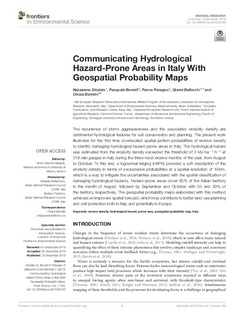| dc.contributor.author | Diodato, Nazzareno | |
| dc.contributor.author | borrelli, Pasquale | |
| dc.contributor.author | Panagos, Panos | |
| dc.contributor.author | Bellocchi, Gianni | |
| dc.contributor.author | Bertolin, Chiara | |
| dc.date.accessioned | 2019-12-13T07:29:01Z | |
| dc.date.available | 2019-12-13T07:29:01Z | |
| dc.date.created | 2019-12-12T14:04:50Z | |
| dc.date.issued | 2019 | |
| dc.identifier.citation | Frontiers in Environmental Science. 2019, 7 . | nb_NO |
| dc.identifier.issn | 2296-665X | |
| dc.identifier.uri | http://hdl.handle.net/11250/2633048 | |
| dc.description.abstract | The recurrence of storm aggressiveness and the associated erosivity density are detrimental hydrological features for soil conservation and planning. The present work illustrates for the first time downscaled spatial pattern probabilities of erosive density to identify damaging hydrological hazard-prone areas in Italy. The hydrological hazard was estimated from the erosivity density exceeded the threshold of 3 MJ ha−1 h −1 at 219 rain gauges in Italy during the three most erosive months of the year, from August to October. To this end, a lognormal kriging (LNPK) provided a soft description of the erosivity density in terms of exceedance probabilities at a spatial resolution of 10 km, which is a way to mitigate the uncertainties associated with the spatial classification of damaging hydrological hazards. Hazard-prone areas cover 65% of the Italian territory in the month of August, followed by September and October with 50 and 30% of the territory, respectively. The geospatial probability maps elaborated with this method achieved an improved spatial forecast, which may contribute to better land-use planning and civil protection both in Italy and potentially in Europe. | nb_NO |
| dc.language.iso | eng | nb_NO |
| dc.publisher | Frontiers Media | nb_NO |
| dc.rights | Navngivelse 4.0 Internasjonal | * |
| dc.rights.uri | http://creativecommons.org/licenses/by/4.0/deed.no | * |
| dc.title | Communicating hydrological hazard-prone areas in Italy with geospatial probability maps | nb_NO |
| dc.type | Journal article | nb_NO |
| dc.type | Peer reviewed | nb_NO |
| dc.description.version | publishedVersion | nb_NO |
| dc.source.pagenumber | 11 | nb_NO |
| dc.source.volume | 7 | nb_NO |
| dc.source.journal | Frontiers in Environmental Science | nb_NO |
| dc.identifier.doi | 10.3389/fenvs.2019.00193 | |
| dc.identifier.cristin | 1760091 | |
| dc.description.localcode | Copyright © 2019 Diodato, Borrelli, Panagos, Bellocchi and Bertolin. This is an open-access article distributed under the terms of the Creative Commons Attribution License (CC BY). The use, distribution or reproduction in other forums is permitted, provided the original author(s) and the copyright owner(s) are credited and that the original publication in this journal is cited, in accordance with accepted academic practice. No use, distribution or reproduction is permitted which does not comply with these terms. | nb_NO |
| cristin.unitcode | 194,64,92,0 | |
| cristin.unitname | Institutt for maskinteknikk og produksjon | |
| cristin.ispublished | true | |
| cristin.fulltext | original | |
| cristin.qualitycode | 1 | |

